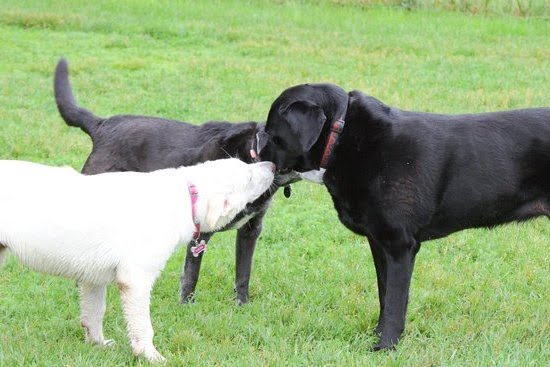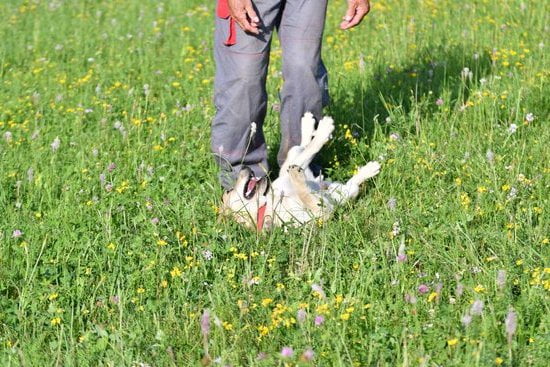How to train a dog to not bite strangers is a common concern for many dog owners. It’s important to understand the root cause of this behavior and learn effective techniques to address it. In this article, we will explore the various factors that contribute to why dogs bite strangers and provide practical tips on how to train your dog to overcome this instinct.
One of the key aspects of training a dog not to bite strangers is understanding the underlying reasons for their behavior. By recognizing the root cause, whether it’s fear, anxiety, or territorial instincts, you can begin to implement strategies that address these issues effectively.
In addition, we will discuss signs of aggression that you should look out for in your dog and how to identify them early on. We’ll also delve into socialization techniques that can help introduce your dog to new people in a positive and non-threatening way. Through positive reinforcement training and consistent routines, you can establish rules and boundaries for your dog’s interactions with strangers.
Furthermore, we will explore when it may be necessary to seek professional help from a dog trainer or behaviorist, as well as safety measures for managing your dog’s behavior around strangers. By examining real-life case studies of successfully trained dogs, you can gain valuable insights into how these methods have proven effective in addressing this issue.
Signs of Aggression to Look Out for in Your Dog
Understanding your dog’s body language is crucial in preventing them from biting strangers. There are several signs of aggression to watch for in your dog. One of the most obvious signs is growling or showing their teeth when approached by a stranger. Additionally, if your dog has a stiff posture, raised hackles, or a fixed stare, these are all indications that they may be feeling threatened and potentially aggressive.
Another sign to watch out for is if your dog starts to bark excessively when around strangers. This could be their way of expressing fear or discomfort with the new person in their environment. It’s important to pay attention to these cues and take action to prevent any potential biting incidents.
In addition, if your dog has previously shown possessive behavior over toys, food, or other items, this could also be an indication that they might exhibit aggression towards strangers who unknowingly approach them while they’re in possession of these items. By being aware of these signs and addressing them early on, you can effectively train your dog to not bite strangers and ensure the safety of others around them.
| Signs of Aggression | Description |
|---|---|
| Growling/Showing Teeth | Dogs may display aggressive tendencies by growling or baring their teeth when feeling threatened. |
| Barking Excessively | Excessive barking can be a sign of fear or discomfort around strangers. |
| Possessive Behavior | Dogs who exhibit possessiveness over toys, food, or other items may also show signs of aggression towards strangers who approach them. |
Socialization Techniques
Socializing your dog is an important aspect of preventing them from biting strangers. Proper socialization can help your dog feel more comfortable around new people and reduce their likelihood of displaying aggressive behavior. There are several techniques you can utilize to introduce your dog to new individuals in a positive and controlled manner.
Gradual Exposure
One effective technique for introducing your dog to new people is gradual exposure. Start by allowing your dog to observe unfamiliar individuals from a distance, gradually decreasing the distance over time as they become more comfortable. This gradual exposure can help prevent overwhelming your dog and minimize their stress when encountering strangers.
Positive Reinforcement
Using positive reinforcement during socialization can also be very effective. When introducing your dog to new people, have those individuals offer treats or engage in play with your dog. This positive association with strangers can help reduce any fear or anxiety your dog may have and encourage them to view new people in a more positive light.
Supervised Interactions
It’s important to always supervise interactions between your dog and strangers, especially during the initial stages of socialization. This allows you to closely monitor your dog’s behavior and intervene if necessary. Keep interactions brief at first, gradually increasing the duration as your dog becomes more comfortable. Supervised interactions also provide an opportunity for you to praise and reward your dog for calm and non-aggressive behavior around new people.
Positive Reinforcement Training
When it comes to training your dog not to bite strangers, positive reinforcement is a highly effective method. This approach involves rewarding your dog for exhibiting good behavior, such as remaining calm and not showing signs of aggression when meeting new people. By rewarding your dog for acting appropriately around strangers, you can help them associate positive experiences with these interactions.
Here are some positive reinforcement techniques you can use to train your dog not to bite strangers:
1. Treats: Use small, tasty treats to reward your dog for good behavior when they are introduced to new people. This can help them learn that staying calm and friendly leads to a delicious reward.
2. Verbal Praise: Dogs respond well to verbal praise, so be sure to enthusiastically praise and pet your dog when they interact with strangers in a calm and friendly manner.
3. Toys or Playtime: For some dogs, playtime with their favorite toy can be just as rewarding as treats. Use their favorite toy as a reward for not displaying aggression towards strangers.
By consistently using positive reinforcement techniques, you can effectively train your dog not to bite strangers while also strengthening the bond between you and your pet.
Remember that patience and consistency are key when using positive reinforcement training methods. It may take time for your dog to fully understand what is expected of them, so be sure to remain patient and continue reinforcing good behavior whenever possible.
Setting Boundaries
One effective way to set boundaries for your dog’s interaction with strangers is by using a leash and harness when out in public. This not only ensures that you have control over your dog, but it also signals to others that your dog may need space. In addition, teaching your dog a command such as “leave it” or “stay” can be helpful in managing their behavior around strangers.
Another important aspect of setting boundaries is educating others on how to approach and interact with your dog. Proper communication with strangers can prevent unnecessary conflict or misunderstandings that may lead to aggressive behavior from the dog. It’s essential to advocate for your pet and politely ask people to give your dog space if needed.
Consistency in enforcing these boundaries is key to successfully training your dog. Make sure everyone in the household and anyone who comes into contact with the dog follows the established rules for interacting with strangers. Reinforce positive behavior and discourage negative behavior consistently, so the dog understands what is expected of them at all times.
Consistency Is Key
When it comes to training a dog to not bite strangers, consistency is crucial. Dogs thrive on routine and repetition, so it’s important to establish a consistent training schedule and stick to it. Whether you’re working on socialization techniques or positive reinforcement training, maintaining a regular routine will help reinforce the desired behaviors and minimize the chances of your dog reverting to old habits.
One way to maintain consistency in your training routine is to set aside dedicated time each day for training exercises. This can include practicing introductions with new people, working on obedience commands, or implementing positive reinforcement techniques. By making training a part of your daily routine, you’ll be able to track your dog’s progress more effectively and address any issues that may arise in a timely manner.
In addition to daily training sessions, it’s important to remain consistent in your expectations and responses to your dog’s behavior. This means setting clear boundaries for interaction with strangers and consistently reinforcing those boundaries. It also means being patient and understanding that behavior change takes time, so staying committed to the training process is essential for success.
| Training Techniques | Consistent Daily Practice |
|---|---|
| Socialization techniques | Dedicated time each day for practicing introductions with new people |
| Positive reinforcement training | Incorporating obedience commands into daily routines |
Seeking Professional Help
Understanding the Role of a Dog Trainer or Behaviorist
Dog trainers and behaviorists are professionals who specialize in understanding dog behavior and can provide valuable insight into why your dog may be exhibiting aggressive behavior towards strangers. They are trained to identify root causes of aggression and develop personalized training plans to address these issues. A dog trainer or behaviorist can assess your dog’s behavior, provide guidance on socialization techniques, and offer strategies for positive reinforcement training.
When to Seek Professional Help
If you have tried various training methods with little success, or if your dog’s aggressive behavior is posing a risk to others, it may be time to consult a professional. Signs that indicate the need for professional help include persistent aggressive behavior, difficulty controlling your dog around strangers, or if there has been an actual biting incident. Seeking professional help early on can prevent escalation of the problem and ensure the safety of both your dog and others.
Working Collaboratively With a Professional
When working with a dog trainer or behaviorist, it is important to communicate openly about your goals and concerns regarding your dog’s behavior. Be prepared to follow their guidance consistently in order to see results.
Keep in mind that changing a dog’s behavior takes time and effort, so patience will be key throughout the process. By collaborating with a professional, you can gain valuable knowledge and skills to continue training your dog effectively even after the sessions are over.
Safety Measures
When it comes to ensuring the safety of others around your dog, there are several important measures that you can take. By implementing these strategies, you can help prevent any incidents of biting or aggression towards strangers.
Here are some safety measures to consider when managing your dog’s behavior around strangers:
- Use a leash and muzzle in public: When taking your dog out in public spaces where there will be strangers present, it’s important to have them on a leash at all times. Additionally, if your dog has a history of aggression towards strangers, using a muzzle can be an extra safety precaution.
- Provide a safe space at home: If you’re expecting visitors to your home, make sure that your dog has a designated safe space where they can retreat to if they feel anxious or overwhelmed. This could be a comfortable bed or crate in a quiet room where they won’t be bothered.
- Supervise interactions: When introducing your dog to new people, always supervise the interaction closely. Keep an eye on both your dog’s body language and the behavior of the person they are interacting with. If you notice any signs of discomfort or aggression from either party, intervene immediately.
- Educate others on how to approach your dog: It’s essential to communicate with others about how to properly interact with your dog. Teach them about the best way to approach and greet your pet without causing any stress or fear.
By implementing these safety measures, you can help ensure that your dog’s interactions with strangers are as safe and positive as possible. Remember that every dog is different, so it’s important to tailor these strategies to suit the specific needs and behaviors of your own pet.
Case Studies
In conclusion, training a dog to not bite strangers requires patience, consistency, and the understanding of the root cause of their behavior. By recognizing signs of aggression in your dog and implementing socialization techniques, such as gradual introductions to new people, you can help your dog feel more comfortable around strangers. Positive reinforcement training is also crucial in rewarding good behavior and setting boundaries for interaction with unfamiliar individuals.
It is important to establish a consistent training routine and seek professional help if needed. Consulting a dog trainer or behaviorist can provide you with valuable insights and guidance on how to effectively address your dog’s biting behavior. Additionally, implementing safety measures, such as using a muzzle or leash when around strangers, can help manage your dog’s behavior and prevent potential incidents.
Case studies serve as real-life examples of successful training methods that have effectively prevented dogs from biting strangers. By learning from these experiences and applying them to your own training approach, you can work towards creating a safe and positive environment for both your dog and others. With dedication and the right techniques, it is possible to train your dog to not bite strangers.
Frequently Asked Questions
How Can I Stop My Dog From Biting Strangers?
If your dog is biting strangers, it’s important to address this behavior as soon as possible. First, identify the triggers that make your dog anxious or aggressive towards strangers.
Once you understand the root cause of the behavior, work on socializing your dog with different people in a controlled environment. Using positive reinforcement techniques can also help, such as rewarding your dog for calm and non-aggressive behavior around strangers.
How Do I Train My Dog Not to Be Aggressive Towards Strangers?
Training a dog not to be aggressive towards strangers involves a combination of desensitization, counter-conditioning, and positive reinforcement. Start by gradually exposing your dog to strangers at a distance where they feel comfortable and rewarding calm behavior.
As they become more at ease, slowly decrease the distance until they can interact with strangers without showing aggression. Consistency and patience are key when training a dog to be less aggressive towards unfamiliar people.
Can a Dog Be Trained Not to Bite People?
Yes, it is absolutely possible to train a dog not to bite people. Whether it’s through obedience training, socialization, or working with a professional trainer, dogs can learn appropriate behaviors around humans.
It’s important to remember that some dogs may require more time and effort than others, so having realistic expectations and seeking professional guidance if needed is crucial when training a dog not to bite people. Remember that every dog is an individual and their response to training may vary.

Welcome to the blog! I am a professional dog trainer and have been working with dogs for many years. In this blog, I will be discussing various topics related to dog training, including tips, tricks, and advice. I hope you find this information helpful and informative. Thanks for reading!





